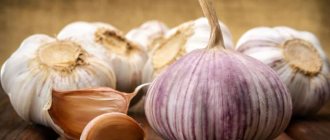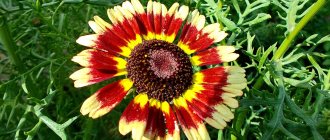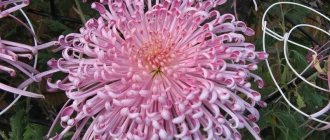Photo from the site: Postroiv.ru
With the onset of autumn, beautiful flowers with a tart, bitter and spicy scent open in the gardens and homes of flower growers. We are talking about chrysanthemums, beautiful fragments of sunny summer, left to us by nature itself, in order to somehow decorate the dull autumn season. However, many flora lovers are concerned with the question of why the home chrysanthemum does not bloom, and the buds stubbornly refuse to appear on tall stems with rich foliage. Sometimes this happens, it’s true, and experienced specialists know for sure that there are completely objective reasons for this, but we’ll try to find out what they are in order to give some practical advice to those who really decided to please their family and friends with large autumn flowers.
Fertilizers and growth and flowering stimulants
Chrysanthemums love loose, nutritious soil and do not like fresh organic matter. When preparing the soil for planting, add, if necessary, peat and sand, as well as the mineral fertilizer Borofoska (50-70 g/sq. m.). Ready-made organic fertilizers are usually applied into the hole, about a handful per plant. In June, as a nitrogen-captium fertilizer, the plants are treated twice per leaf with a solution of calcium nitrate.
In the first half of July, they are fed with a superphosphate extract solution, and from the end of July until flowering, three feedings are given with fertilizer with a predominance of potassium. For example, potassium monophosphate is an excellent fertilizer for explosive flowering; it is used both for watering and for spraying on the leaf (10 g per 10 liters of water). You can use potassium sulfate or an infusion of wood ash.
Also, at the end of July, it is recommended to treat for early and abundant flowering with Mag-Bor fertilizer in the form of foliar feeding (7-10 g per 5 liters of water). Throughout the season, periodic treatments are carried out with Novosil and Potassium Humate to stimulate growth, flowering and increase plant resistance to disease.
Plant the chrysanthemum in several places in the garden to choose the most suitable area according to the microclimate, where the plant will show itself in all its glory and require minimal care.
Why do the leaves turn yellow?
Leaves can dry out for several reasons. Main: heat. When the temperature is too high, the leaves of the plants turn yellow and the buds dry out. In this case, you should try to place the flower in a cool place. Other reasons:
- depleted soil;
- abundant watering;
- pests
If everything is in order with the tops and the indicated reasons are not found, you need to carefully dig up the flower and carefully examine the roots. If rotting occurs, remove all rotten parts and plant the chrysanthemum in another pot with fresh, damp soil.
Attention! You can't water for a few days!
If garden plants don't bloom
The reasons why chrysanthemum does not bloom in the open ground of a summer cottage are practically the same as for the indoor variety, with the only difference being that the garden crop is greatly influenced by weather conditions, which should be taken into account at the time of care, as well as when choosing a planting site plants, i.e. at the initial stage of growing a flower.
You can make a chrysanthemum bloom in the garden by avoiding a number of the most common mistakes that lead to a lack of flowering.
- Insufficiently nutritious soil. Chrysanthemums do not like slightly acidic and neutral soils. The soil should be loose and drained, as well as fertilized (compost, peat, rotted manure).
- Bad place. There is not enough lighting or the place is too wet in itself, where water stagnates. Strong winds also have a negative effect, so the bush needs to be planted in a windproof place. Too bright light from garden lights also has an effect, disrupting the biorhythms of the plant, the flowering of which depends on the length of daylight hours.
- Excessive watering.
- Lack of space. To receive nutrients, air and sunlight, bushes in open ground need some space, a sufficient amount of nutrients, the distance between bushes should not be less than 40 cm.
- Diseases.
- Unfavorable climate.
If a chrysanthemum does not bloom outside, try to figure out the reasons and find the most effective way to solve the problem.
Artificial stimulation of flowering
If late varieties of chrysanthemums do not have time to bloom, methods can be used to artificially stimulate flowering.
Special growth and flowering stimulants, available in gardening stores and departments, can force plants to bloom ahead of schedule. They must be used according to the instructions so as not to harm the chrysanthemum.
The second method involves periodic pruning of bushes. As a result, the buds will grow faster.
Many people love chrysanthemums because they bloom in late autumn, when there are almost no other flowers to be found in nature. Of course, every housewife wants a lush flower bed of chrysanthemums. But sometimes the plants don't bloom. It's very frustrating. If chrysanthemums do not bloom in the garden, what to do? To correct the situation, you should know the reasons why this happens. It is about them that we will write in this article. From it you will learn how to make chrysanthemums bloom in the garden.
Agricultural technology
In order for chrysanthemums to really delight with their flowering, not to get sick and to develop well, they need good lighting. In dimly lit places, the chrysanthemum begins to stretch upward, becomes sluggish and incapable of flowering. To plant flowers, choose the brightest and warmest place in the garden so that other plants and buildings do not shade them throughout the day.
Chrysanthemum is considered a flower of short daylight hours; its buds set and actively grow at a time when the days are longer than the nights. When this balance changes in favor of night and daylight hours decrease, buds begin to form and bloom faster.
It is necessary to germinate and cut chrysanthemums in early spring. To wait for abundant flowering, the mother chrysanthemum must be removed from storage in early March. You cannot plant the entire chrysanthemum bush in the soil; the flower is propagated by cuttings.
3 weeks before spring cuttings, the mother plant is taken out of storage to a bright but cool place, with a temperature within +15 degrees. Soon the shoots will begin to grow, when they reach 5-7 cm, they need to be cut off and planted in separate containers.
Sometimes shoots with roots form on the mother bush; they need to be separated and planted in another container, as an independent plant.
For rooting chrysanthemums, the soil mixture is prepared from turf soil, humus and sand, taken in proportions 2x2x1. The cuttings should be covered with a transparent film and opened for ventilation and moisture for several hours a day. To speed up the rooting of cuttings, they are provided with additional lighting and heating of the containers from below.
Every 10 days, the cuttings should be fed with complex mineral fertilizers diluted in water, according to the instructions - 2 tbsp. spoons into a bucket of water. Adult chrysanthemums also need to be fed throughout the flowering period.
Seedlings can be planted in open ground in the last ten days of May, with a distance of 40-50 cm. When the bush in the garden gains green mass, the soil is fertilized with nitrogenous fertilizers; for this you can make a solution of bird droppings (1x20) or a solution of mullein (1x10). Urea is dissolved in water at the rate of 1 tablespoon per bucket of water.
During the formation of buds, the plant needs potassium-phosphorus fertilizers - superphosphate and potassium nitrate.
The soil of chrysanthemums should always be moist, especially in dry, hot weather.
Why is this so important for the plant? Without water, the stems and leaves become sluggish, their elasticity decreases, the plant loses its ability to bloom and resist diseases and pests. In summer, chrysanthemums in the garden need to be watered every day, and sometimes twice a day.
To properly form a bush, chrysanthemums need to be pinched and removed in time. At the end of spring - beginning of summer, a so-called zero bud appears on the bush; if it is removed, the bush will begin to bloom in September, and if left - in August.
After the young bushes are planted in open ground, they are accepted and begin to grow; their tops need to be pinched so that side shoots with buds are formed.
Sometimes the chrysanthemum bush turns out to be lush, with a large number of buds that never open. Why is this happening? If many shoots grow from below the bush, all its strength is spent on their development, and the chrysanthemum does not bloom. To avoid this, it is enough to leave the three strongest shoots and remove the rest.
Regulating the flowering time of chrysanthemums
In the difficult climatic conditions of Russia, summer residents want the crops they lovingly grow in their plots to bloom for as long as possible. One of the most popular garden plants are chrysanthemums. They bloom in the fall, when all nature is withering, which greatly enhances the landscape of this time of year. But many gardeners strive to speed up the flowering of chrysanthemums in order to enjoy the bright colors longer. Sometimes this is difficult due to problems in the plant.
Watering and fertilizing
Plants love moisture, which is why in the spring they need to be watered very thoroughly before the inflorescences appear.
Water the flowers with soft rain or settled water. For softness, you can drop 3 drops of ammonia there. If flowers lack moisture, their stems become rough.
They like manure and mineral fertilizers. When planting cuttings in the spring, it is best to use nitrogen so that the plant grows green mass, and then phosphorus and potassium for the development of inflorescences.
You can water plants with fertilizers only at the roots, since if the fertilizer gets on the leaves, they will burn.
The substance nitrogen helps the stems grow, grow a large number of shoots, give the leaves a bright green color, and the inflorescences the color characteristic of this variety. When there is a lack of nitrogen, chrysanthemum leaves turn yellow, this is called chlorosis. The inflorescences will be small and inconspicuous. In early spring, seedlings are fed with ammonia nitrogen, and when inflorescences form - with nitrates.
Applying fertilizers to the soil
Nitrogen helps the cutting create protein; it stores what it needs for good development. Nitrogen is an excellent fertilizer, so it must be added to the soil in the spring. And in the fall, nitrogen is not added, as the plant gradually stops growing. Its rhizomes begin to prepare for winter. If you add nitrogen in the fall, the plant will die.
When the plant becomes a powerful bush and begins to form buds, it requires phosphorus and potassium. Phosphorus helps plants bloom intensively and for a long time, improves their immunity. Superphosphate is added at 50 g per 1 m2 of area, and bone meal is also added. Potassium also has a good effect on the health and beauty of inflorescences. Potassium sulfate is considered the best fertilizer.
When young seedlings are growing, it is very important that they have enough nutrients for the first 8 weeks. Then they very intensively increase their vegetative mass
At this time, you need to follow the fertilizer proportions: 2 parts nitrogen to 1 part phosphorus and 1 part potassium, plus add the necessary microelements.
Pour 2 buckets of manure or 1 bucket of bird droppings into a barrel, pour water into it, mix thoroughly, leave for 3 days, after which the fertilizer will be ready. To feed the seedlings: pour 1 liter of infusion, dilute it with a bucket of water (10 l). Water 1 liter of mixture at the root of each sprout. Water the sprouts generously before fertilizing.
Instead of chemical fertilizers, you can feed the seedlings with nettles. It contains nitrogen, phosphorus, potassium, as well as many trace elements.
But to obtain a nutrient mixture, you must follow the rules: collect nettles when they have not yet formed seeds; select only healthy nettles; keep the composition in the light, then it will ferment faster. To ferment faster, add yeast. To prevent the infusion from smelling so disgusting, add a root of valerian.
Take a bucket or barrel, mow or pick nettles. Then it is recommended to grind it. Fill 2/3 of a bucket or barrel with nettles. Fill the container to the top with warm water. Cover her. Stir the mixture every day. Then the oxygen that is released during fermentation will escape. The composition is completely ready in 5-10 days. The warmer the weather, the faster the composition will turn out. The infusion is ready when it has fermented. It becomes lighter, the bubbles disappear. The finished composition is diluted as follows: for 1 liter of infusion - a bucket of water (10 liters). The seedlings are watered with this.
Store the composition in the same container in which it was prepared. Water chrysanthemums once every 14 days. After watering with nettle solution, you need to water the plants generously.
You can add dandelions to nettles. They are collected before the seeds appear, dried a little, and cut. The barrel is filled 1/8 with dandelions. Then add up to 2/4 of the barrel of nettle. Pour water with a solution of humate, add 1 teaspoon to a bucket of water (10 l).
Preparation of fertilizers from nettles
This composition is infused for 4-5 days. You can add ash or Cinderella fertilizer to the finished infusion, 100 g per 100 l.
You can add other weeds to the nettle infusion: tomato shoots, shepherd's purse, larkspur (comfrey), coltsfoot, achillea (yarrow), dandur (wheatgrass), chamomile, wormwood.
Feeding the plant in the spring is the main part of caring for it. Right before flowering, you can fertilize the plants with special products on the leaves; they can be purchased in stores. Fertilizers are a 100% guarantee of good growth and development of chrysanthemums.
Flower care: expert advice
Which fertilizer to choose
Beginning gardeners often have the question of what to feed chrysanthemums for good flowering. Different means are used at different times of the year.
In the spring, it is necessary to enrich the soil with organic fertilizers. They need to be brought in to a considerable depth.
Of the mineral fertilizers at the initial stage of development, nitrogen-containing options are needed. They help accelerate the rise in height, increase the number of young shoots, and also provide rich color to the plant. When applying nitrogen fertilizing, it is necessary to avoid contact with the above-ground parts of the plant, as this can cause burns.
In summer, you need to reduce the use of nitrogen to a minimum so that the plant stems do not become too long and the flowers small. Give preference to potassium instead. The special regulator “Bud” is favorable for the flowering of chrysanthemums.
At the end of summer and beginning of autumn, it is necessary to completely eliminate nitrogen from the diet of chrysanthemums. During this period, the main emphasis should be on potassium and phosphorus. One square meter of garden plot requires 40 g of potassium and 25 g of phosphorus.
Is it possible to plant chrysanthemums in the fall?
Most experts in this field believe that autumn planting of perennial chrysanthemums should be carried out only in warm regions, giving preference to small-flowered varieties. In addition, this is the most common time when planting material is sold at markets. Flower growers have the opportunity to evaluate the bush, its height, size and color of the inflorescences.
It is better to buy early flowering chrysanthemums no later than September, and the plant should bloom profusely.
As a rule, flowering seedlings are sold by people who grow cut flowers, and sellers often grow late-flowering varieties in their greenhouses to prolong flowering. Next autumn, the chrysanthemum does not have time to bloom in our gardens; due to frost, all the long-awaited beauty disappears.
Some tips for planting chrysanthemums in the fall:
- The optimal time for planting is considered to be the end of September - the first half of October;
- You should not plant flowering bushes - there is a high risk that they will not take root;
- For planting, it is better to choose bushes on which basal shoots have formed.
- Before frost, planted chrysanthemums must have time to get stronger in order to withstand winter frosts well.
- Don’t forget to mulch the soil with a layer of peat or compost, and before frosts in November, it’s better to cover it with something to protect it from the cold.
General information
Chrysanthemums belong to the Asteraceae family; there are many varieties, many of them late, that bloom until the first frost. There are several ways to grow these flowers:
- in open ground;
- in pots;
- in the flower beds;
- in greenhouses.
You can combine all these methods, taking into account the variety - flowering of certain types of chrysanthemums can occur when grown only by a specific method. The signal for flowering is a decrease in daylight hours - the duration of the night becomes longer. A problem that often arises is that some varieties do not bloom until the first frost. Before solving it, you should find out why chrysanthemum flowering is difficult; it is necessary to determine whether the variety belongs to one group or another.
Chrysanthemums are divided into 3 groups according to flowering time:
- early ones, which bloom in July or August, fade in October;
- medium-blooming ones delight with flowers from October, they need 7-8 weeks to set buds;
- late varieties are called so because they begin to bloom in late autumn - in November.
The flowering of chrysanthemums depends on the size of the inflorescences - the smaller it is, the faster they bloom.
The flowering of chrysanthemums depends on many factors
Reasons for lack of flowering
One of the obvious reasons is errors in caring for a certain variety, which begin to appear from the moment of planting. They can be grouped:
- varieties of Korean chrysanthemum should be grown in pots indoors; they are low-growing, therefore compact and mobile - the pots can be moved, but not exposed to the cold;
- Chinese chrysanthemums have a similar appearance, but their maintenance conditions are slightly different;
- varieties of Indian chrysanthemums are universal - they can be kept in open ground only in summer, but in winter they must be at above-zero temperatures.
Chrysanthemum buds do not bloom for several reasons:
- a small amount of sunlight, it is not enough to force the buds to open; light-loving varieties, including many indoor ones, need sunlight for at least 8 hours a day;
- excess sunlight can also have a detrimental effect on the plant - not only will it not bloom, but it will dry out and the leaves will turn yellow;
- lack of space can become a significant problem both for flowers growing in a pot and for those grown in open ground - the roots grow quickly, occupying all the space, leaving no room for free access of water and air;
- excessive watering can lead to the appearance of fungus and woodiness of the stems, which inhibits the onset of flowering; disruption of biorhythms, when chrysanthemums cannot distinguish day from night, occurs when artificial lighting is used;
- errors in fertilizing - in addition to organic matter, the plant needs a balanced application of inorganic fertilizers, nitrogen-containing fertilizers have the greatest influence on the flowering of chrysanthemums, they are applied during the growing season, phosphorus is also extremely important, stimulating the development of flowers and preserving them in cut form, potassium is responsible for the appearance of flowers , which is best given to the plant in the summer; in the process of adding nutrients, regularity is important - once every 12-14 days;
- diseases and pests also do not bypass chrysanthemums; it is necessary to subject them to regular inspection; the most dangerous are powdery mildew, gray mold, scale insects, spider mites; fungicides and insecticides are effective against them.
You can speed up the onset of flowering with proper pruning and pinching:
- It is necessary to pinch flowers annually starting from the first year of life;
- shoots that are too long need to be cut off - they interfere with the development of buds;
- flowers that fade should be cut off immediately;
- In order to get a blooming chrysanthemum as early as possible, you should not pinch the so-called zero bud, which appears in May; this applies to plants with large flowers.
A few more recommendations to help speed up the appearance of flowering buds:
varieties suffering from excess sun need to be provided with shade in the form of curtains and blinds, this is especially important after 19:00; it is necessary to remove abundant flower ovaries in a timely manner; Treatments once a week with Zircon are useful; You can sometimes use growth stimulants after first checking the reaction of a given variety to it;
it is necessary to apply phosphorus-potassium fertilizers once a week during the period of active growth;
- in order to accustom a plant to twilight, starting in August or early autumn, it is necessary to limit the access of light by using special dense materials and changing its location;
- from the end of summer, gradually reduce the volume of water when watering.
An effective method is flowering control, when the growth and development of chrysanthemums is calculated in detail, and varieties are selected so that they bloom at specific times. With this method, not only do all processes proceed faster, but it also becomes possible to receive freshly cut flowers 3 times a year.
The main task is to properly ensure access to light at different periods of plant development:
- in spring, it is enough for the plant to receive light no more than 10 hours a day; the amount of light can be reduced using dark materials;
- during active growing season in August, there should be at least 14 hours of daylight, high temperature, and abundant watering;
- after budding, chrysanthemums need a small amount of sunlight - 10-12 hours, the temperature around the clock should be at least 20 ° C for chrysanthemums to bloom;
- In autumn and winter, artificial lighting using lamps or better natural light and heating are extremely important so that the temperature in the greenhouse is 20 ° C.
Methods for accelerating flowering
To know how to speed up the flowering of chrysanthemums, you need to understand what problems are associated with this process. Main mistakes:
- incorrect choice of place for growing;
- insufficient space between planted seedlings;
- improper or irregular care;
- diseases, pest damage.
For every problem there is a right solution. The place for growing chrysanthemums should be sufficiently lit:
- in spring, the plant should receive a maximum of 10 hours of light per day;
- during the period of active budding (August), daylight hours should be at least 14 hours;
- after the growing season, chrysanthemum needs 10-12 hours of light.
Favorable temperatures are also required for growth:
- on sunny days – +16°С…+25°С;
- on cloudy days – maximum +20°С;
- at night – in the range of 15-17°C.
In hot weather, chrysanthemum buds burn out and the flowering stage becomes shorter. At low temperatures, the growth process slows down, the buds remain loose and unformed. With increased humidity and cold, the risk of powdery mildew, gray mold and other diseases increases.
The soil also plays an important role. The soil should be neutral or weakly acidic, loose and well absorbing water.
If planted incorrectly (insufficient distance between seedlings), the plant needs to find another place in the garden bed. Every 2-3 years in the spring it is recommended to replant so that the flower “lives through” all stages and blooms without problems.
One of the most important and important stages of proper care is feeding. At the growing season, to accelerate the appearance of chrysanthemum flowers, they need a smooth change in nutrition: nitrates instead of ammonia nitrogen. Phosphorus is responsible for the duration of flowering and its abundance, so it is necessary to supplement the nitrogen component with phosphorus-potassium fertilizers. Also, thanks to this mineral, the plant’s immunity is strengthened. Proportions for applying fertilizer per square meter of soil: 1: 1: 1.8, nitrogen and phosphorus - 25 g, potassium - 45 g. To enhance the effectiveness of fertilizing, it is recommended to apply it to moist soil after rain or watering. Humidity promotes faster absorption and even distribution. Nitrogen-containing fertilizers cause burns if they come into contact with the stem and leaves, so when fertilizing chrysanthemums, you should work in the beds carefully.
Each disease or pest has its own methods of control. In most cases, fungicide treatment is used.
Additional measures
Proper pruning and pinching can speed up the formation of buds and the start of flowering:
- Pinching is recommended to be carried out annually, starting from the first year;
- long branches need to be cut off, because they interfere with the growth of buds;
- In chrysanthemum varieties with large flowers, you cannot remove the first bud, which is formed in May and is responsible for the early flowering of the chrysanthemum.
Instead of chemicals, you can also use traditional methods of fertilization: manure and droppings, infusions of nettles and dandelions.
Aftercare
It is not difficult to germinate cuttings planted in the ground: you must not forget about watering, ventilation, temperature, lighting
It is important to periodically remove the film, ventilating the “greenhouse” and removing condensation. The fact that the root system has appeared and is developing will be indicated by growing young leaves.
However, before planting in open ground, you will have to transplant the plant into a separate container.
It is necessary to provide the plant with the best conditions for the formation and development of the root system. In order for side shoots to appear and the bush to become lush, it is necessary to pinch the top. As soon as the first leaves appear, you can fertilize. This will allow the root mass to grow faster. However, nitrogen fertilizers must be applied in doses.
We must not forget about timely loosening. The root system must breathe, so it develops faster. If you are afraid of damaging the roots, you can resort to mulching.
After 2 weeks from the moment the first leaves appear, you can start feeding the petioles with minerals. Fertilizers for flowering plants are suitable. However, in order to prevent burns to the roots, fertilizing must be diluted more than usual. Solutions must be weaker than the values specified in the instructions. Do not allow fertilizer to get on the leaves.
It happens that after transplanting into soil from water, the plant begins to wither. Fine root hairs disappear in the soil - they dry out in the ground. In this case, an intermediate transplant is necessary. Pour the substrate into the container, compact it slightly, and water it.
Then a small depression is made in the center and the cutting is placed in it. Fill the hole with vermiculite; it will absorb water and prevent the fine hairs from drying out. After the bush has grown, it can be planted in a flowerbed or transplanted into a larger pot and grown as a houseplant.
Needs of the "Golden Flower"
The plant is demanding on soil quality. Chrysanthemum will not grow on heavy clay soils unless sand is first mixed into it. Tall varieties need increased watering and you need to choose a warmer place so that the wind cannot damage the shoots.
During the growing season, that is, starting from 2 - 3 degrees Celsius, the bush should be opened slightly to allow air to enter. The mulch is completely removed in mid-May. How to feed a chrysanthemum at the initial stage:
infusion of mullein or chicken droppings;
complex mineral fertilizer;
wood ash.
Video: Features of caring for chrysanthemums - expert review
Nitrogen, which stimulates the growth of leaves and shoots, is contained in manure. There is also a sufficient amount of potassium for budding. It is not recommended to use fresh manure, as it contains a large amount of ammonia, which can destroy the root system in a couple of days. Therefore, it must be insisted on as follows:
Fill a third of the bucket with manure or chicken droppings;
to fill with water;
stand for a week, stirring occasionally so that excess ammonia evaporates;
then dilute 1 liter of mullein with 10 liters of water, and chicken manure with 20 liters.
Water at the root, making sure that the solution does not get on the leaves.
Phosphorus must be added separately in the form of superphosphates, bone meal or ash, since without it the metabolism in the plant will be incomplete - the root system will not develop and will not be able to supply nutrition to the leaves and shoots.
Therefore, there will be no abundant flowering. Superphosphate is diluted according to the dosage in the instructions. It contains potassium. If you add it at the same time as mullein, then at the budding stage there will be no shortage of potassium nutrition.
It is advisable to apply bone meal or ash to feed chrysanthemums in the fall. During the winter, these substances have time to decompose by soil microorganisms and transform into a form that can be absorbed by plants.
How to determine battery deficiency
If fertilizing of chrysanthemums before flowering was not carried out in full, the appearance of the leaves and shoots will help determine what exactly is missing:
Thin shoots and light leaves indicate that the plant lacks nitrogen nutrition. In this case, you can urgently spray with a urea solution. 1 tablespoon of substance per 10 liters of water.
If the leaves begin to dry around the edges, then it’s time to add potassium sulfate. 1 teaspoon per 10 liters of water.
The leaves change color to purple-blue - the plant needs phosphorus.
For a chrysanthemum to bloom, it needs a full range of nutrients and they need to be added to the soil in August or early autumn. This applies more to potassium-phosphorus fertilizers.
Nitrogen substances are added shortly before planting - in the spring, so that the main element does not evaporate and go deep into the soil. In the fall, you can apply fresh manure to your new flower bed. During the winter it overheats and becomes harmless to the roots. If chrysanthemums are already growing in the flowerbed, then fresh mullein is not used.
Chemicals are used to control pests, such as the meadow bug.
During intensive feeding of chrysanthemums, the plant needs increased watering. The need for liquid decreases by a third by the end of flowering.
Treatment against aphids
Aphids are a dangerous enemy of chrysanthemums, feeding on plant sap. As a result, the flower is dehydrated and deprived of nutrients. This leads to drying of the shoots, deformation of the leaves and falling off of the buds. Typically, pests are localized on the lower part of the leaves of the plant, where their accumulation can be seen.
To combat aphids, there is a wide selection of special chemicals - “Aktara”, “Metafos”, “Karbofos”, “Fosfomid”, “Confidor” and others. The packaging of each product contains detailed instructions, following which you need to prepare the solution.
It is necessary to treat the chrysanthemum with the resulting solution from the root part to the tips of the leaves and the topmost buds.
Read also: How to properly plant raspberry seedlings in the fall
In addition to ready-made chemical insecticides, there are many traditional methods of combating aphids. The following options are considered the most effective:
- Ammonia diluted with water in proportions 1:10. Fill a spray bottle with this solution and then use it to spray the plant. After 2-3 days, it is recommended to treat the plant again.
- Grind 2-3 garlic cloves, add 250 ml of hot water and leave for 1.5 hours. Then filter and dilute with water until the volume reaches a liter. During the day, use for spraying chrysanthemums at intervals of 3-4 hours.
- Dry and chop the citrus peel. Pour a liter of boiling water and place in a dark place to steep for three days. After this, strain the resulting infusion and use it to irrigate chrysanthemums.
How to create the best conditions for chrysanthemums?
At home, the ideal temperature for chrysanthemums is a low air temperature - from +15 to +18°C, but not everyone has the opportunity to keep the plant in such conditions, since apartments are usually much warmer - up to +20+22°C.
An increase in temperature can be fraught for chrysanthemums with withering of buds, yellowing of leaves and a reduction in the flowering period to a minimum.
Very often, at high air temperatures, another problem occurs: aphid attack. In this case, regular treatment of the plant with a solution of soap or an effective insecticide is necessary.
Temperature changes are especially dangerous for young plants that have not yet had time to adapt to living conditions in an apartment. Adaptation is worth mentioning separately. Having brought a wildly blooming, beautiful chrysanthemum from the store, let it get used to the new conditions for 2 weeks, and then be sure to replant, otherwise the plant will die.
Bushes can be planted several in one container
The main condition is that the pot must be wide, since chrysanthemums have a large branched root system, and it is important to provide it with sufficient living space
Remember also to have good drainage at the bottom of the pot to prevent the soil from becoming waterlogged.
Care for the chrysanthemum correctly, be attentive to it, and soon it will delight you with amazing flowers with a slightly bitter, cool aroma.
News from partners:
2 comments
Chrysanthemum is a beautiful flower and not only can it be seen in the garden or country house, but also at home. Usually the chrysanthemum is an autumn flower, when all the flowers have faded and nature is preparing for winter, but here in your garden different shades of lilac and white chrysanthemum balls have bloomed.
I love chrysanthemums very much)) There were 4 attempts at growing flowers at home. They simply died. I wonder what kind of watering they need? Room temperature water? And how often? Still, I’ll buy the flower again and replant it in a larger pot :)
The incomparable beauty of chrysanthemum is very popular among many gardeners. But recently, growing it at home has become increasingly common. For such cases, even special varieties of plants have been bred and grown in nurseries. Of course, caring for an indoor chrysanthemum requires a little more effort than one that grows outdoors. But the effort is worth the result - you will get brightly blooming, beautiful flowers that will decorate your windows for a long time.
Some people believe that chrysanthemum is a disposable plant, and after it has bloomed, all that remains is to throw it away. In fact, a flower can bring you joy for years, so when a chrysanthemum in a pot has faded, you need to take the following steps.
Diseases and pests
Pests and diseases are dangerous for chrysanthemum flowering. Therefore, you need to deal with them in a timely manner, choosing effective methods.
Root rot
The causative agent of root rot in chrysanthemums is the parasitic fungal complex Rhizoctonia solani. The disease develops in conditions of close planting, excessive humidity and too high temperatures.
To combat infection, it is necessary to carry out a soil disinfection procedure with Bazamid or Formalin. For prevention, it is necessary to maintain a favorable balance of air and water regimes.
Baldness of buds
This problem can be caused by various factors - diseases, pests or violations of flower care rules. In any case, if the chrysanthemum buds develop poorly or are completely bald, all flower stalks must be removed.
Rust
Characteristic brown spots on shoots, flowers and leaves indicate infection with a fungal infection such as rust. All infected parts of the plant must be removed and treated with fungicidal preparations.
Septoria
Another dangerous fungal disease. Infected parts of the plant first acquire a brown tint, then turn black and begin to die. The solution will be to destroy the affected areas and then treat the plant with Fundazol or another antifungal agent. To prevent infection of other plants, the diseased specimen must be quarantined for two weeks. After the course of treatment, the flower should be washed with a warm shower and watered.
Aphids, scale insects, spider mites
To combat these pests, the drugs Antiklesch, Fitoverm, and Neoron are effective. You can also use folk remedies for spraying plants - an infusion of garlic and onion peels, a decoction of yarrow and dandelion roots, as well as a solution of laundry soap.
Main reasons
Among the main reasons for the lack of flowering of chrysanthemums are errors in choosing a location, lack of space between seedlings, improper or insufficient care, diseases or exposure to pests. In each situation, you should find the right solution to the problem.
Closeness
Over time, chrysanthemum bushes grow greatly. When there is a shortage of free space, the volume of nutritious soil allocated for each plant decreases. The consequence of this is a lack of oxygen and nutrients needed by flowers. In addition, plant grounds become vulnerable to pests. To avoid this, you should not grow chrysanthemums in the same place for more than three years.
The problem of crowding will be solved by replanting the plant. The chrysanthemum quickly sprouts new shoots. After replanting, growth and flowering become more intense.
Wrong place on the street
Chrysanthemums run the risk of not blooming if they grow in too dark a place with high humidity. It is better to plant it on a hill, moderately illuminated by the sun and blown by the wind.
Insufficiently nutritious soil
A deficiency of useful nutritional components in the soil negatively affects the flowering of garden chrysanthemums. The soil becomes depleted if chrysanthemums grow in their original places for too long. Therefore, the supply of nutrients responsible for normal flowering is completely exhausted. The solution to the problem is to replant or feed the plant.
Abundant watering during bud formation
During the budding period, chrysanthemum needs a little water. If you water it too often and in large quantities, flowering will stop. Instead, the plant will noticeably lengthen its stem and enlarge its leaves.
Diseases
Despite the fact that chrysanthemums are characterized by resistance to most diseases, sometimes it is this factor that prevents the onset of flowering.
Fusarium is a fungal disease, the causative agent of which penetrates from the soil through the roots and prevents the flow of water into the plant tissue. As a result, the leaves turn yellow or brown prematurely, plant growth slows down, and flowers are unable to form. For treatment and prevention, universal fungicidal solutions are used.
Mosaic is a dangerous viral disease that leads to wilting and yellowing of leaves. Flowers can form, but they are too small and inconspicuous.
As preventive measures, it is recommended to use only high-quality planting material, plant flowers at a considerable distance from each other, and promptly destroy insects that carry the disease.
Unsuitable climate for the variety
Some varieties of garden chrysanthemums react painfully to changing climatic conditions
Exotic flowers brought from abroad may not feel well. Therefore, in order for the chrysanthemum to delight with beautiful and stable flowering, it is better to give preference to those varieties that are well adapted to the local climate conditions
The most favorable climate for chrysanthemums is a warm, not hot climate with moderate humidity. In such conditions, it blooms earlier and delights others with its beauty for a long time.
How to speed up flowering
There are several simple secrets of caring for chrysanthemums that will speed up flowering.
Choosing a place in the garden
When choosing a suitable place for chrysanthemums in the garden, you need to take into account criteria such as humidity level, degree of illumination and favorable conditions.
The quality and composition of the soil in the garden plot is of no small importance. She must be:
- moisture permeable;
- loose;
- rich in nutritional components;
- slightly acidic or neutral.
Illumination
The consequences of insufficient lighting are:
- stretching shoots;
- weakening of the plant structure;
- delay in characteristic flowering periods.
Chrysanthemums feel most comfortable in a sunny area located on a small hill.
Temperature
The most favorable temperature for the growth and flowering of chrysanthemums is:
- in sunny weather - from +16 °C to +25 °C;
- in cloudy conditions - up to +20 °C;
- at night - within +16-17 °C.
If +25 degrees is exceeded, chrysanthemum inflorescences burn out. The flowering period is shortened. At low temperatures, growth slows down, inflorescences form poorly, remaining soft and loose. In combination with high humidity, low temperatures increase the plant's susceptibility to powdery mildew, gray mold and other ailments.
Humidity
It is highly undesirable to plant chrysanthemums in shady places where there is a possibility of moisture retention. In conditions of excessive dampness, they have difficulty surviving the winter. Drought also adversely affects bud formation and subsequent flowering.
Spring work
With the onset of spring, it is imperative to remove the tops and branches. But it is not necessary to sweep away the peat. This is mulch and fertilizer, without which it will be difficult to expect good flowering. After the root growth has appeared, it is removed using pruning shears. The resulting cuttings are 6-7 cm long. They need to be dipped in the Kornevin solution and planted on a bed with well-fertilized soil, on top of which there is a layer of sand (about 2 cm).
It is imperative to spray and water the cuttings every day. You need to stretch the film on top and be sure to provide shading from bright, sunlight. Don’t forget to ventilate, and within 2 weeks your plantings will produce good roots.
Young plants are planted in a permanent place in May, when the threat of frost has passed. Don't forget to water and mulch the soil well. As soon as the height of your plants reaches 15 cm, the most painstaking work begins. To get a tall stem with a lush flower, you must pinch off all the side shoots and buds, leaving one. Moreover, the choice is not always obvious; the central one may turn out to be underdeveloped or ugly, so you need to carefully monitor your plant.
Wintering in the ground
Since chrysanthemums are perennial flowers, they have good cold resistance. Therefore, garden soil is a normal wintering environment for such plants. However, in order to preserve flowers in open ground, it is necessary to take some steps to protect them from the cold.
- mulching;
- shelter;
- trenches.
Let's look at each option in more detail.
Mulching
This method is suitable for varieties that are highly cold-resistant. When the first frost occurs, it is necessary to hill up the bushes. For this you can use shavings, sawdust, humus, compost, peat, etc.
If the region is characterized by frosty winters, then the plants must be covered with spruce branches or branches, which should be sprinkled with dry leaves on top.
Shelter
This wintering method is considered more reliable than mulching, so it is usually used in areas with harsh winters.
In autumn, supports should be installed around chrysanthemums. Ordinary bricks can play their role. Slate or board is placed on top of the supports. On top of this structure is covered with a covering material, which must be fixed. You can cover the flowers with spruce branches or special materials (for example, lutrasil or spandbond).
The shelter is dismantled in the spring, when the night frosts have already passed and the weather is relatively warm outside. If the risk of frost returning is high, then a plastic bag is placed over the plants.
Trenches
Another way to winter chrysanthemums is in a trench. The method involves digging a ditch 70 cm wide and deep. The length of the trench is determined by the number of bushes that need to be protected from the cold.
It is worth noting that until the first frost the plants are stored open. They are covered only after a significant cold snap. After frost, roofing felt/slate is covered with sawdust, dry leaves or peat. The bulk layer must have a thickness of at least 50 cm. A plastic film is installed on top of the embankment.
Of all the options, this method is the most labor-intensive. You can remove flowers from such trenches for planting when good weather in the spring has settled and the ground has warmed up sufficiently.
How to properly store in winter
A successful wintering of chrysanthemums is the key to their rich flowering next year. For different plant varieties, different winter storage methods should be selected:
- in open ground with shelter;
- in the basement;
- in the trenches.
Frost-resistant varieties are able to spend the entire winter period in open ground. However, for this they need reliable shelter, so in the fall you need to prepare dry leaves in large quantities. A leaf layer half a meter thick must be laid on the bushes as soon as the first frosts begin.
Additional cover needs to be placed on top of the leaves - this can be household plastic film, thin dried branches or a grapevine. This provides protection from gusts of wind.
Storage in the basement is optimal for most varieties. The place must meet the requirements:
- maintaining air temperature from 0 to +4 degrees;
- good ventilation and normal humidity;
- absence of pests and fungi.
How to propagate home chrysanthemum
Indoor chrysanthemums are usually propagated by cuttings. Planting material is obtained during formative pruning of the crown: powerful stems are shortened by 10-15 cm, cut cuttings are planted in a moist substrate and the container is covered with film or glass. The greenhouse is regularly watered and ventilated. After the roots appear, the cuttings are planted in pots of suitable size and then cared for in the same way as adult plants.
Propagation by cuttings is the most effective, affordable and fairly simple way to obtain new bushes, which cannot be said about growing from seeds at home. The seed method requires patience and attention and often does not guarantee obtaining specimens that fully preserve the individual characteristics of the variety. Before propagating chrysanthemums indoors with seeds, you must understand: using this method makes sense only when cuttings for some reason are not possible.
Features of indoor chrysanthemums
This flower can be either annual or perennial. It has a branched root system, the development of which occurs parallel to the surface. The leaves of the plant are light green and are dissected, serrated or notched. A dense inflorescence is formed by small flowers collected in a basket.
Indoor chrysanthemum has a large number of varieties that grow wonderfully at home. These types differ from garden ones in their miniature size. This is explained by the fact that for growing indoors they use drugs that stop their growth for decorative purposes.
When purchasing a chrysanthemum for growing in pots, you should choose a strong and healthy specimen with a well-formed stem and dense foliage. After purchase, the flower adapts to new conditions for some time. To prevent the plant from becoming infected with diseases from other indoor flowers, it is quarantined for several days.











